Bundesliga MD 05 Preview: Bayern vs. Frankfurt
“We have changed our build-up play a little bit in order to play in certain spaces”, said Leon Goretzka after the 4-0 victory over Atlético Madrid. Insights into the tactical setup of a team are usually rare. Often this is due to journalists asking rather simple questions that elicit the usual off-the-shelf one word answers.
But since Hansi Flick became coach at FC Bayern, players have been talking about tactics more regularly – sometimes even of their own accord. Above all, it is noticeable that the analysis of different players directly after the matches quite consistently raises identical issues.
FC Bayern act as a unit
Later, Flick echoed what Goretzka had said: “We tried to use the spaces we had identified as promising.” Now one may ask smugly if this should not be completely normal. After all, both coaches and players are top professionals who are supposed to know the ins and outs of their business.
But there have been times when this common sound was not there, even in simple interviews. Where the analysis seemed to depend on the mood of the player. Not so under Flick. Same spaces, same movements, same orientation, same goals – FC Bayern is a unit on and off the pitch.
And from the perspective of a blog whose bread and butter are the tactical aspects of the beautiful game, such statements are a feast for the ears. You can imagine it working like a well-oiled press: There is a trigger and a resulting response. In this case, the trigger is Goretzka’s statement that the build-up play has been adapted to a certain extent in order to be able to use certain spaces against a deep opponent. And the response? Well, a delighted analysis on the tactical board. Because let us see what Goretzka and Flick might have alluded to.
Analysis: Bayern with subtle but very effective adjustments against Atlético
Typically, Bayern under Flick play with a tucked-in winger and very high overlapping full-backs. In the centre, the game is thus narrowed down based on a lot of movement and good organisation from which the team works out chances through the half spaces – to put it simply.
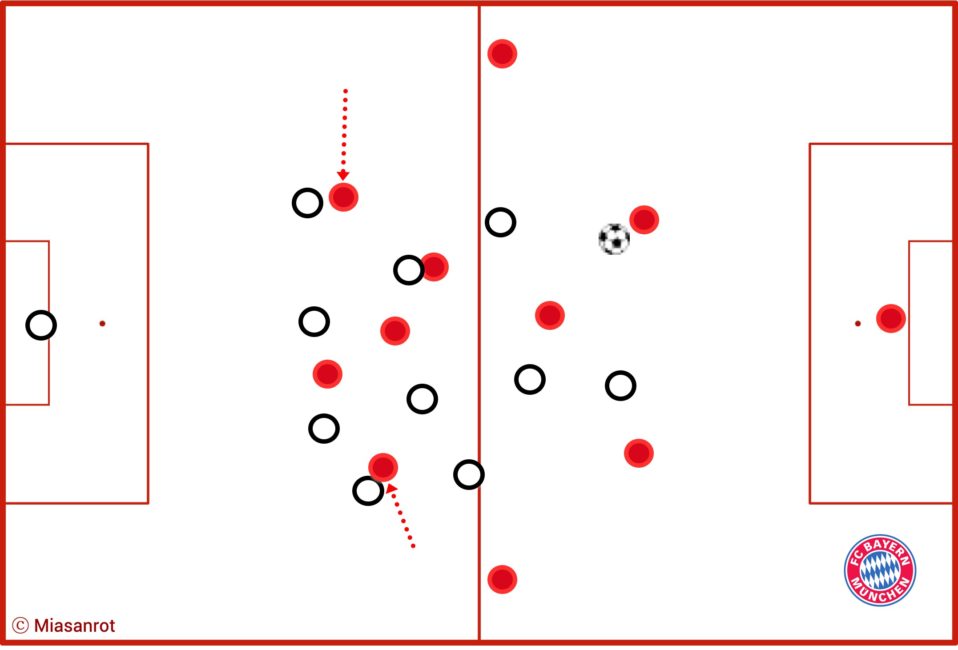
Against Atlético Bayern’s game focused predominantly on the right side. According to the app “SofaScore” the average positions looked something like this:
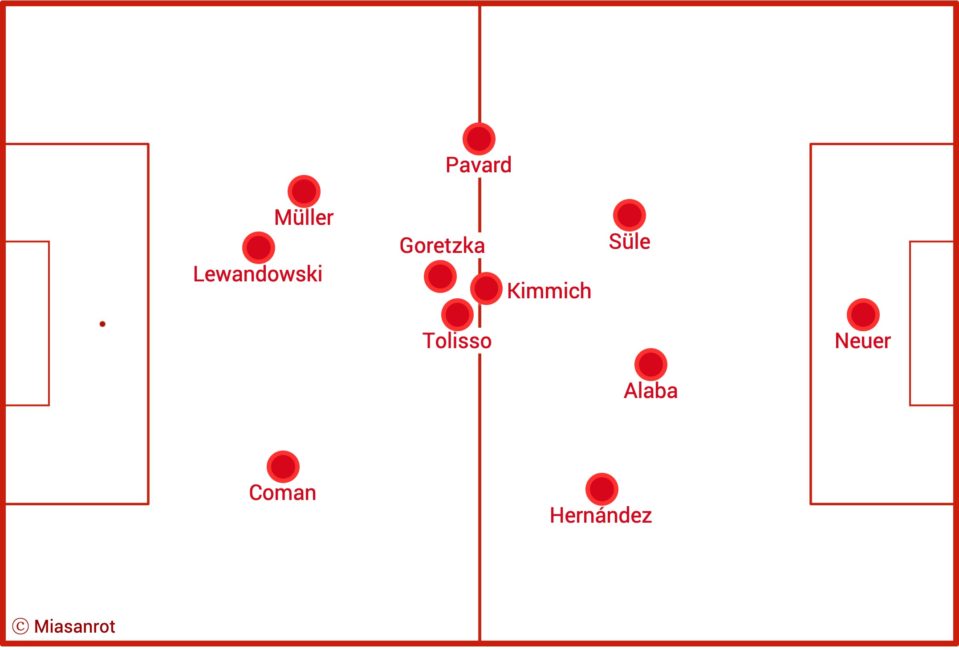
(Nachgestellt, Quelle: SofaScore)
The result: Goretzka, Kimmich and Tolisso rotated a lot, which is why in the graphic their average positions concentrate in the centre. However, their focus was more on the right side of the field. Alaba, Süle and Lewandowski also took up slightly right-shifted positions compared to their standard position. Müller, on the other hand, took, as expected, a strongly tucked in position, while Pavard was on average positioned higher than Hernández. Coman’s average position is considerably wider than Müller’s – and it would probably be even wider if he had not switched to the right side in some phases of the game.
This may already serve to give a rough idea of what Bayern did differently than in the weeks before. After the side from Munich had managed to push Atléticos Pressing backwards through long periods of possession, their shape looked something like this:
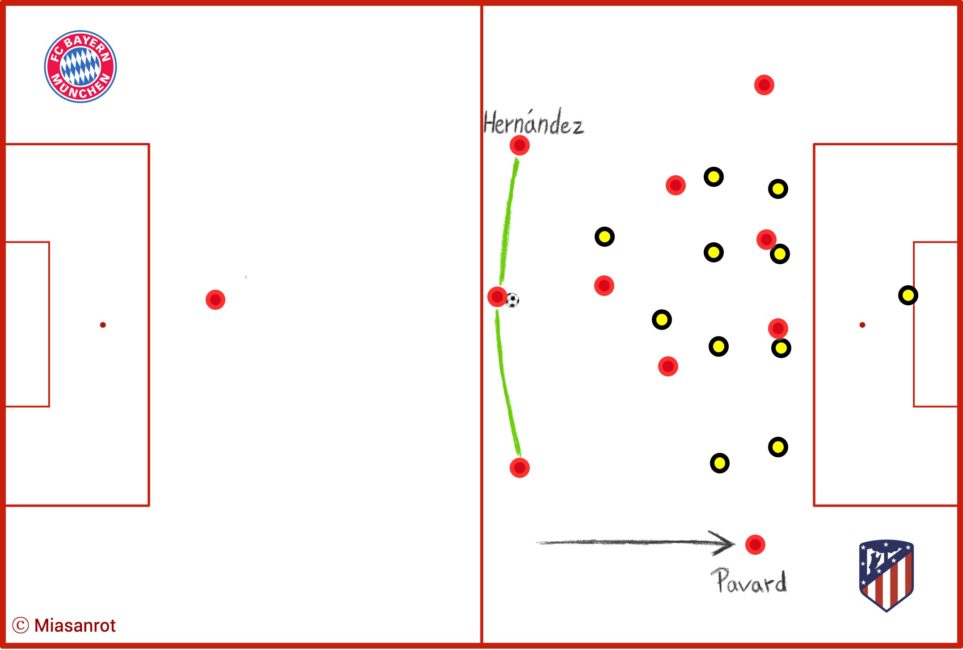
Pavard pushed up while Hernández tended to stay behind, rarely the other way around. As a result, Bayern had at least three players ready to defend counter-attacks in case they lost the ball. Müller, on the other hand, gravitated towards the centre. Interestingly, Bayern then played with a strong right-hand focus. 37% of all attacks went through this side, only 31% down the left – in the Bundesliga the average is 34% right and 42% left.
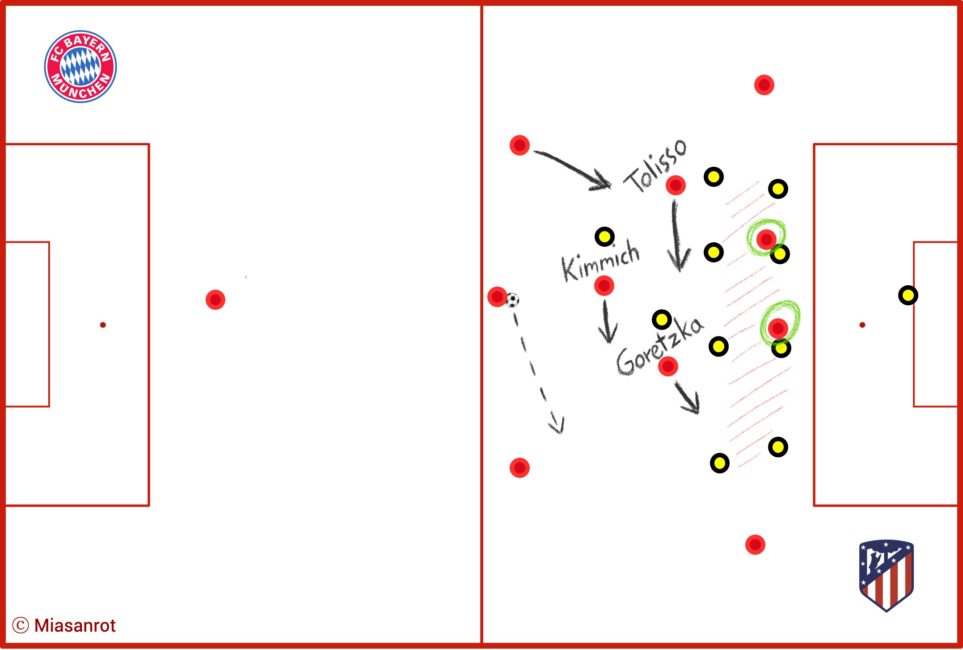
Especially the three central midfielders often worked the right inside channel. Both Kimmich and Goretzka, whose default position was in the inside right channel anyway, and Tolisso, who was actually positioned in the left half space, often moved to the right half of the field. Sometimes it was Hernández who covered Tolisso’s half left position with a diagonal run to provide protection.
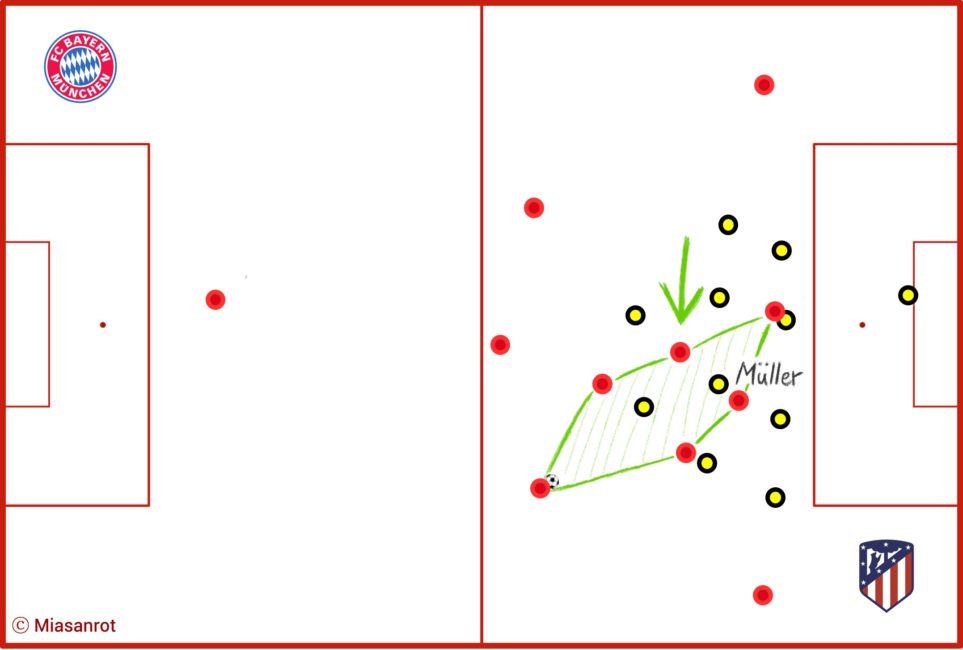
Due to the strong right side focus, Bayern now had several options: For example, they could attempt to use their numerical superiority on the right to create breakthroughs, or enable the pushed up Pavard to receive the ball in a free position. However, such plays were rather incidental.
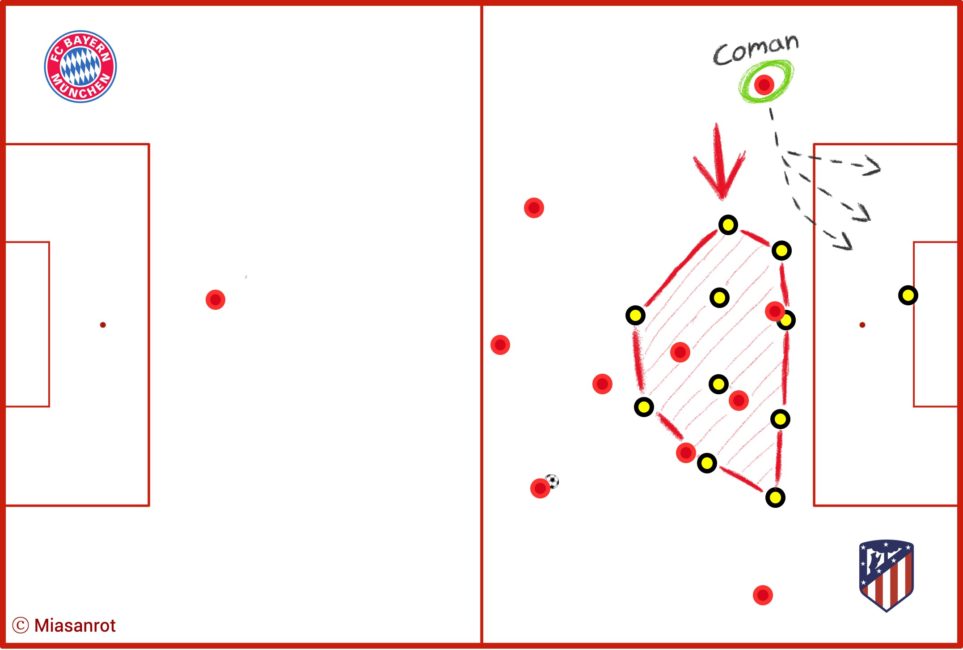
The real aim of the overload was to get Coman in a free position out wide. By now, Atlético’s defense would have taken a very compressed horizontal shape due to Bayern’s right side focus. Especially Kimmich, who was repeatedly given space by Müller, Tolisso and Goretzka, now often shifted the play. This gave Coman the crucial space to immediately accelerate and enter the penalty area at speed. His opponent Trippier for the most part could not deal with Coman’s energy as evidenced by his four successful dribbles.
Back to daily Bundesliga business
So Flick has proved once again that he is adaptable and that has a tactical understanding that is underestimated in many places. He is able to build victories on the drawing board and, despite all previous doubts, continuously elicits performances from his players on the highest mental and physical levels.
And so Bayern picked up where they had left off in the Champions League. They recorded the 12th victory in the 12th Champions League match across seasons with 47 goals to 8 – an average of 3.9 to 0.6 per game. There are no more superlatives for this team.
And that is precisely what will probably make everyday life in the Bundesliga even more challenging this season. Unlike such highlights as the game against Atlético, games in the Bundesliga such as the one against Frankfurt on Saturday will not be about tactical intricacies. They will be about mental and physical resilience in an attempt to go to the limits again and again. Week after week after week …
Precision, efficiency, and patience – against Frankfurt, too?
If only a few percentage points of concentration, willingness to run or intensity are missing, games like those against Hoffenheim or Hertha will not remain the exception. Frankfurt has got off to a good start to the season and has not yet lost a game. However, their opponents so far have only been Bielefeld (1-1), Hertha (3-1), Hoffenheim (2-1) and Cologne (1-1). If you want to oversimplify, Frankfurt managed to achieve two more or less safe victories against two teams that made it difficult for Bayern. On the other hand, the reigning champions achieved a clear victory over Bielefeld.
It is clear that Frankfurt, with their aggressive and usually well-organised game against the ball under Hütter, always pose a danger. But if Bayern play with the precision, efficiency and patience of Wednesday evening, Frankfurt will go away empty-handed. That unfortunately is the simple truth of the matter. In the Bundesliga, even Borussia Dortmund need a lot of luck and a good day to be able to trip up Flick’s team.
Accordingly, Hütter will hope for Bayern to turn up in their Hoffenheim form. And he might possibly even try to emulate Hoeness’s setup. He would have the players for that at least.
It is relatively unlikely that Leon Goretzka after the game will again remark on his team’s subtle adaptations in their structure. Depending on the outcome, the focus may then be more on how the team has accepted the difficult circumstances. In any case, presumably all players will once again be on the same page as their coach. And that is what success can be reduced to – at every level.












Spot on analysis. I also noticed a lot of movement and combination on the right side. Prior to the match, only 1 true winger on the left, one would think logically the attack would focus on the left. It was, but in a much more sophisticated way. Bayern is also getting better at their possession and pressing game, which was not the case vs Hoffenheim and Berlin.
As you pointed out Justin, switching back to the bread and butter Bundesliga, mentally and physically, week in week out, is a great challenge. To me this kind of matches is also about how the team can use them to improve further, how quickly new players can be integrated, for example I would really like to see where Roca is standing in the team, whether he can start to contribute to our midfield control. Still very early for him and others, but time is what we don’t have, so calculated risk when it comes to squad rotation must be taken. I trust Flick to handle this well.